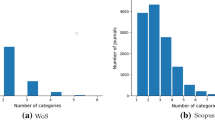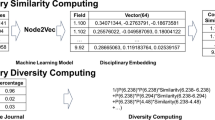Abstract
In order to re-categorize the SCImago Journal & Country Rank (SJR) journals based on Scopus, as well as improve the SJR subject classification scheme, an iterative process built upon reference analysis of citing journals was designed. The first step entailed construction of a matrix containing citing journals and cited categories obtained through the aggregation of cited journals. Assuming that the most representative categories in each journal would be represented by the highest citation values regarding categories, the matrix vectors were reduced using a threshold to discern and discard the weakest relations. The process was refined on the basis of different parameters of a heuristic nature, including (1) the development of several tests applying different thresholds, (2) the designation of a cutoff, (3) the number of iterations to execute, and (4) a manual review operation of a certain amount of multi-categorized journals. Despite certain shortcomings related with journal classification, the method showed a solid performance in grouping journals at a level higher than categories—that is, aggregating journals into subject areas. It also enabled us to redesign the SJR classification scheme, providing for a more cohesive one that covers a good proportion of re-categorized journals.




Similar content being viewed by others
References
Chen, C. M. (2006). CiteSpace II: Detecting and visualizing emerging trends and transient patterns in scientific literature. Journal of the American Society for Information Science and Technology, 57(3), 359–377.
Chen, C. M. (2008). Classification of scientific networks using aggregated journal-journal citation relations in the Journal Citation Reports. Journal of the American Society for Information Science and Technology, 59(14), 2296–2304.
Elsevier. (2002). Scopus. http://www.scopus.com/home.url. Accessed June 20, 2011
Glänzel, W., & Schubert, A. (2003). A new classification scheme of science fields and subfields designed for scientometric evaluation purposes. Scientometrics, 56(3), 357–367.
Glänzel, W., Schubert, A., & Czerwon, H. J. (1999a). An item-by-item subject classification of papers published in multidisciplinary and general journals using reference analysis. Scientometrics, 44(3), 427–439.
Glänzel, W., Schubert, A., Schoepflin, U., & Czerwon, H. J. (1999b). An item-by-item subject classification of papers published in journals covered by the SSCI database using reference analysis. Scientometrics, 46(3), 431–441.
Gómez, I., Bordons, M., Fernández, M. T., & Méndez, A. (1996). Coping with the problem of subject classification diversity. Scientometrics, 35(2), 223–235.
Leydesdorff, L. (2002). Dynamic and evolutionary updates of classificatory schemes in scientific journal structures. Journal of the American Society for Information Science and Technology, 53(12), 987–994.
López-Illescas, C., Noyons, E. C. M., Visser, M. V., Moya-Anegón, F., & Moed, H. F. (2009). Expansion of scientific journal categories using reference analysis: How can it be done and does it make a difference? Scientometrics, 79(3), 473–490.
Narin, F. (1976). Evaluative bibliometrics: The use of publication and citation analysis in the evaluation of scientific activity. Cherry Hill, NJ: Computer Horizons, Inc.
Narin, F., Carpenter, M., & Nancy, C. (1972). Interrelationships of scientific journals. Journal of the American Society for Information Science, 23(5), 323–331.
Narin, F., Pinski, G., & Gee, H. H. (1976). Structure of the biomedical literature. Journal of the American Society for Information Science, 27(1), 25–45.
Pinski, G., & Narin, F. (1976). Citation influence for journal aggregates of scientific publications: Theory, with application to the literature of physics. Information Processing and Management, 12(5), 297–312.
Schubert, A., & Braun, T. (1996). Cross-field normalization of scientometric indicators. Scientometrics, 36(3), 311–324.
Scimago Lab. (2007). Scimago Journal & Country Rank. http://www.scimagojr.com/. Accessed June 20, 2011
Small, H. (1999). A passage through science: Crossing disciplinary boundaries. Library Trends, 48(1), 72–108.
Thomson Reuters. (2010). ISI Web of Science. http://wokinfo.com/products_tools/multidisciplinary/webofscience/. Accessed June 20, 2011.
Weinberg, A. (1963). Criteria for scientific choice. Minerva, 1(2), 159–171.
Acknowledgment
The authors thank Jean Sanders for editing the text.
Author information
Authors and Affiliations
Corresponding author
Appendix
Rights and permissions
About this article
Cite this article
Gómez-Núñez, A.J., Vargas-Quesada, B., de Moya-Anegón, F. et al. Improving SCImago Journal & Country Rank (SJR) subject classification through reference analysis. Scientometrics 89, 741–758 (2011). https://doi.org/10.1007/s11192-011-0485-8
Received:
Published:
Issue Date:
DOI: https://doi.org/10.1007/s11192-011-0485-8




